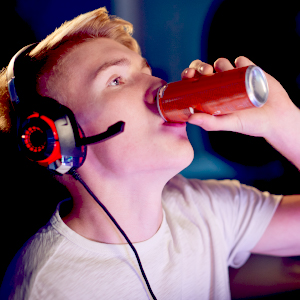Energy drinks are big business. The industry has grown nearly 30 percent in
the past five years, according to “Mintel’s U.S. Energy Drinks Market
Report,” with more and more energy drink choices hitting the shelves of
convenience and grocery stores.
Young people are an easy mark for these drinks, which contain a stimulating
compound (most often caffeine, sugars and other legal stimulants) and are
marketed as a quick way to enhance your mental and physical abilities.
With today’s youth getting less sleep than ever before and mounting
societal pressures to perform at high levels in and out of school, more
teens are relying on energy drinks to get through their busy schedules.
I’ve found that the newer sports-focused energy drinks are particularly
appealing to young athletes who drag through the day, but want to ramp up
their performance at practice or in games.
As a pediatrician with a background in public health, I am increasingly
concerned about the harmful effects of these drinks, and their stimulating
impact on children, teens and young adults.
Caffeine: How Much is Too Much?
Most energy drinks contain caffeine, which is the most commonly used
psychoactive substance available. It’s classified as a stimulant drug
because of its ability to stimulate the central nervous system. The Food
and Drug Administration (FDA) recognizes caffeine as safe when taken in
moderate levels, up to 400 milligrams (mg) per day. At these levels,
caffeine has been shown to be beneficial in lowering the risk of various
diseases such as type II diabetes and Parkinson’s disease.
Four hundred mg of caffeine amounts to about five cups of coffee. The
caffeine level in one energy drink, though, can range from 250 mg to 500
mg. And many of these drinks pack a powerful punch of sugar – as much as 14
teaspoons per beverage, according to the American Academy of Pediatrics.
It’s important to recognize that FDA guidelines are for adults only. Little
research has been done on the effect of caffeine on children and
adolescents. Because so few studies exist, we do not know what the minimum
safe level of caffeine use is for children and teens or what caffeine does
to the developing brain.
What we do know is that when used in excess, caffeine can have serious
health consequences. Adults who have moderate to high caffeine use
experience more disturbed and interrupted sleep, which leads to other
health issues. At higher doses, caffeine can cause body temperature and
blood pressure changes, rapid heart rate, an abnormal heart rhythm,
abdominal cramping and vomiting. In some cases, over- consumption of energy
drinks has been linked to seizures. For kids who have anxiety, caffeine use
can exacerbate symptoms.
The Centers for Disease Control and Prevention tracks emergency room visits
involving energy drinks. From 2007 to 2011, such visits in the United
States doubled to 21,000. About 1,500 of these were made by young people
between the ages of 12 to 17. Though rare, there have been recent incidents
of teens dying from caffeine-induced cardiac problems.
Caffeine Use in Kids and Teens
When it comes to stimulant-containing energy drinks, the recommendation by
the American Academy of Pediatrics is very clear: these drinks have no
place in the diets of children or adolescents.
I advise families to say no to all energy drinks, no matter your child’s
age. Teach your older child to say no, too. Talk to your pre-teens and
teens about energy drinks and what high levels of caffeine can do to them
physically and mentally. Discuss the marketing of these drinks and know the
difference between how sports drinks (no caffeine) and energy drinks are
marketed to young athletes, as kids often confuse the two.
When asked, adolescents and teens will often report having had two to three
cans of energy drinks in any given day. With some leading energy drinks
containing 160 mg of caffeine per 16 oz. can, this is concerning.
Teach teens how to monitor their caffeine intake and how to read labels.
The FDA limits the amount of caffeine that may be in a can of soda (to
.02%, or 71 mg for a 12-oz. drink), and the FDA has taken steps in the last
couple of years to warn consumers about dietary supplements containing pure
and highly concentrated caffeine. But the energy drink industry is not
required to abide by FDA regulations, and there is no federally regulated
limit to the amount of caffeine that may be in an energy drink.
For a child under 12, caffeine in any type of drink has no place in their
diet. Little sips lead to bigger gulps, so it’s best to say no.
For kids ages 12 and up, limit your child’s caffeine intake to the
equivalent of an eight oz. cup of coffee (or about 85-100 mg daily). And be
sure to watch portion size. The cups at popular coffee shops typically hold
a lot more than eight ounces. A quick coffee run at your favorite coffee
chain could mean a caffeine intake of 160-300 mg depending on the size of
the drink.
Don’t make caffeine a daily habit or a reward for behavior. Know, too, that
caffeine can be found in a variety of foods, including some you might never
suspect, such as jellybeans, chocolate, marshmallows and some gum and
mints. There’s even caffeinated water and lip balm.
When talking with kids and their parents, I explain why caffeine should not
be part of a healthy diet for young people. I know that zero caffeine use
may not be possible, but the later kids are exposed to caffeinated drinks,
the better. And avoiding caffeinated energy drinks entirely can go a long
way toward keeping your child’s caffeine intake within a safer range.
Learn more about energy drinks by visiting the Healthy Schools section
of the Centers for Disease Control and Prevention website
(cdc.gov).

